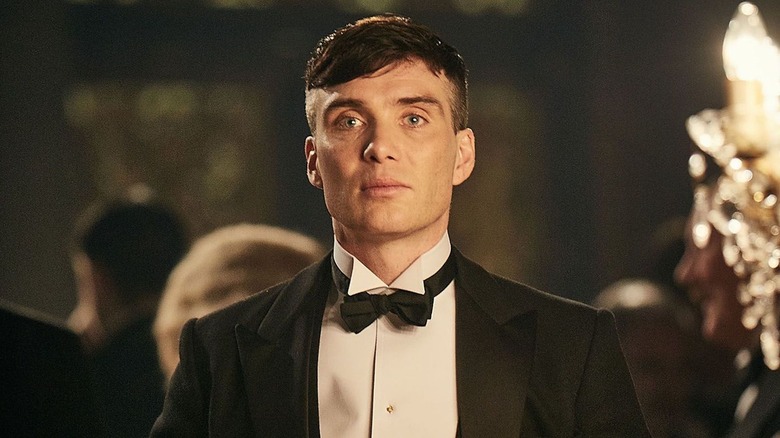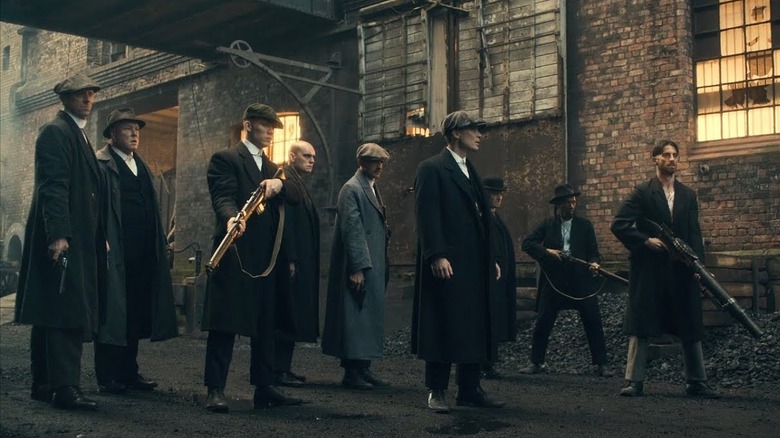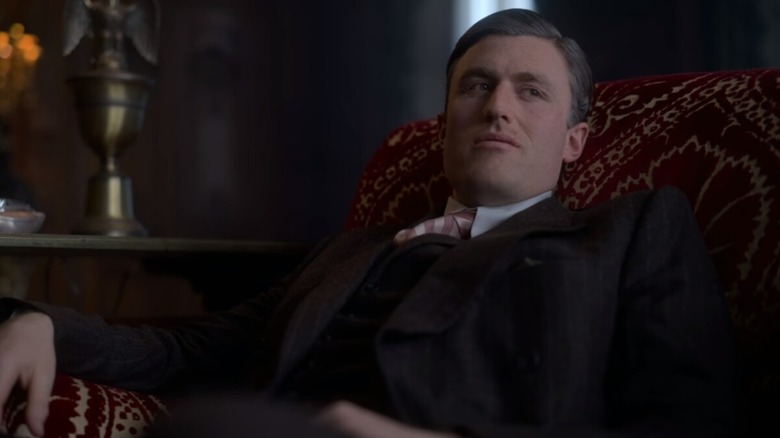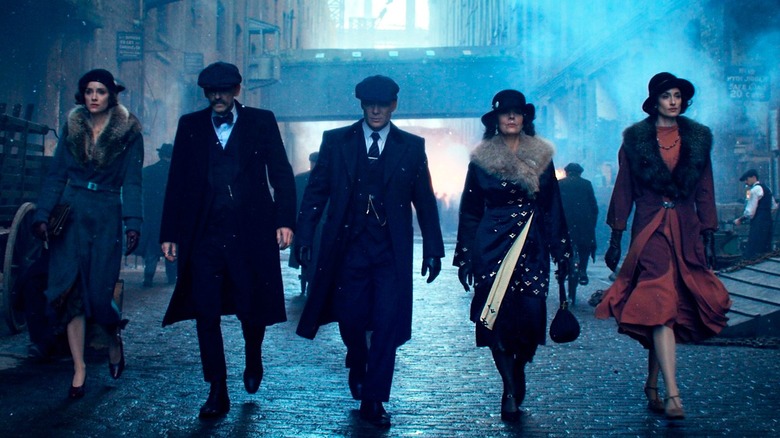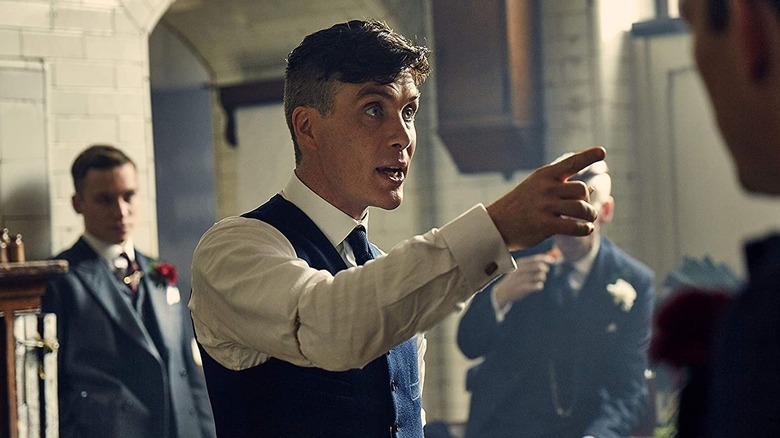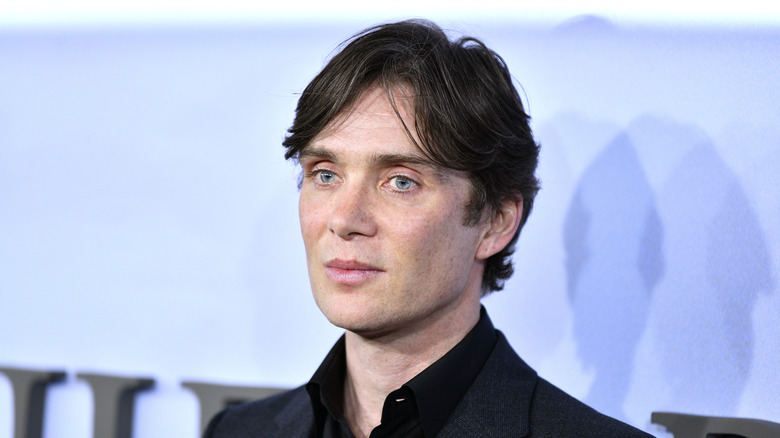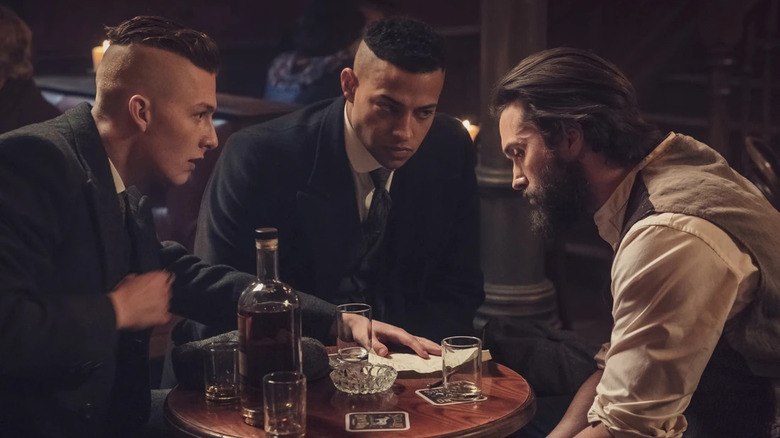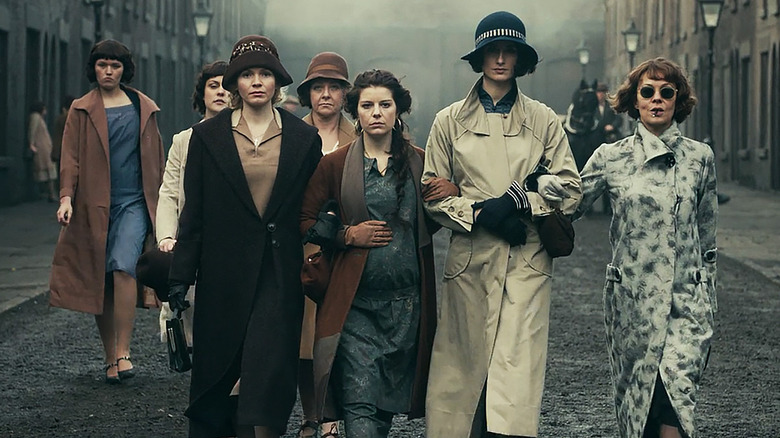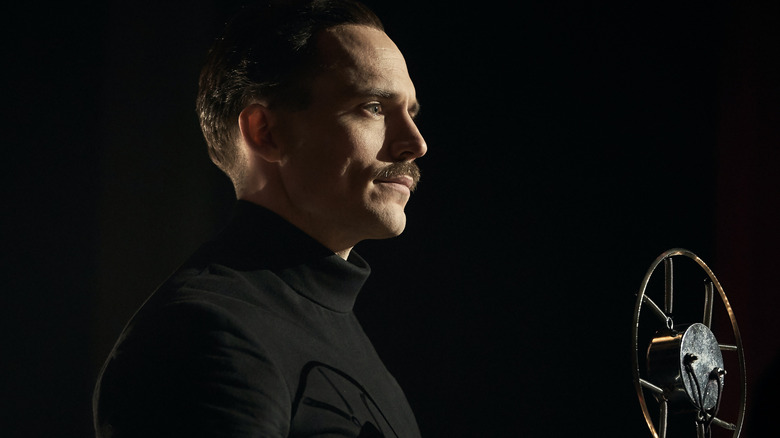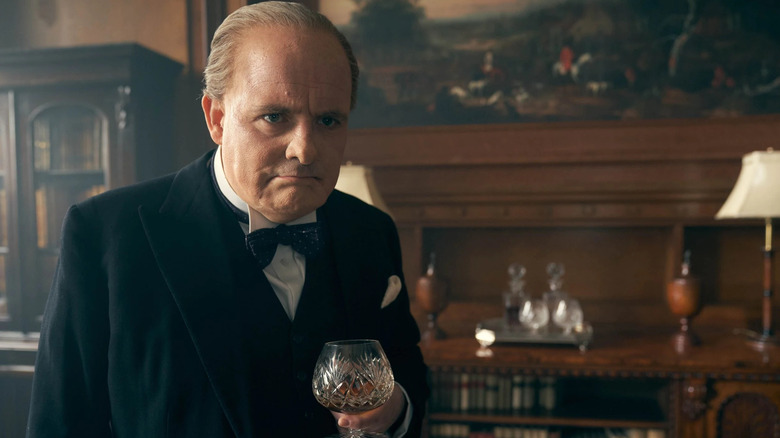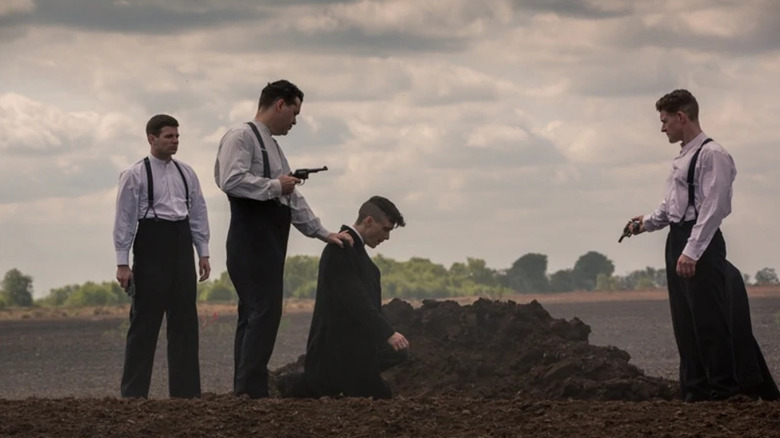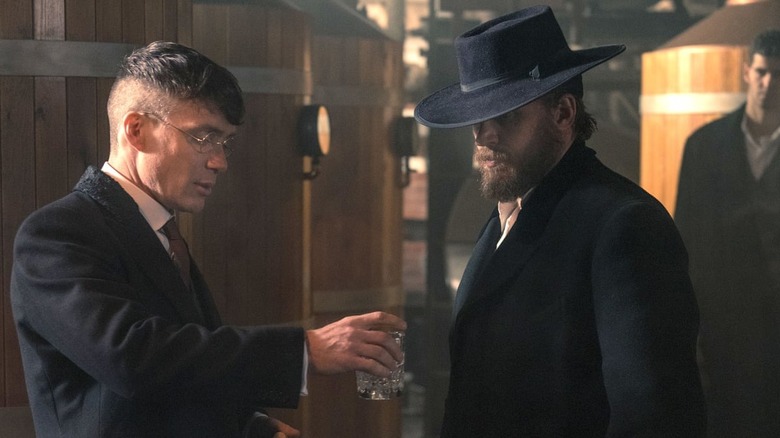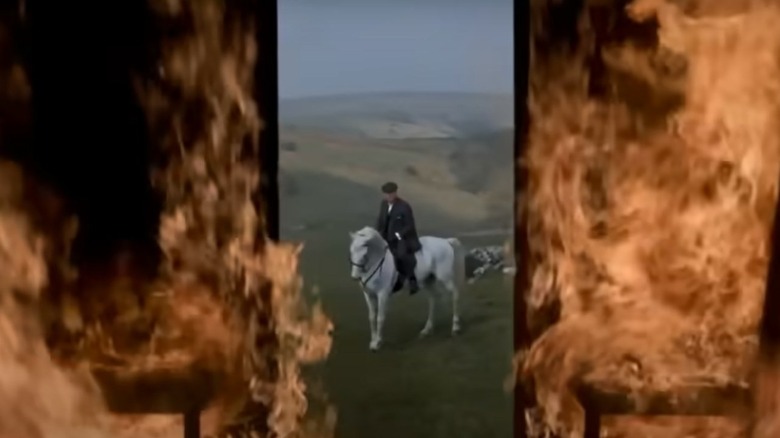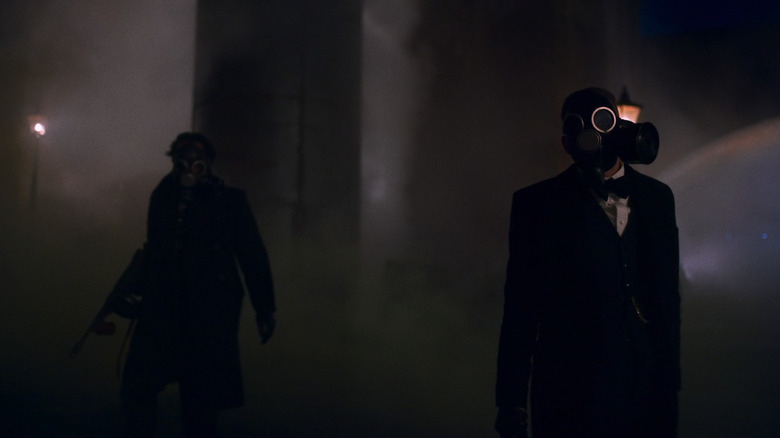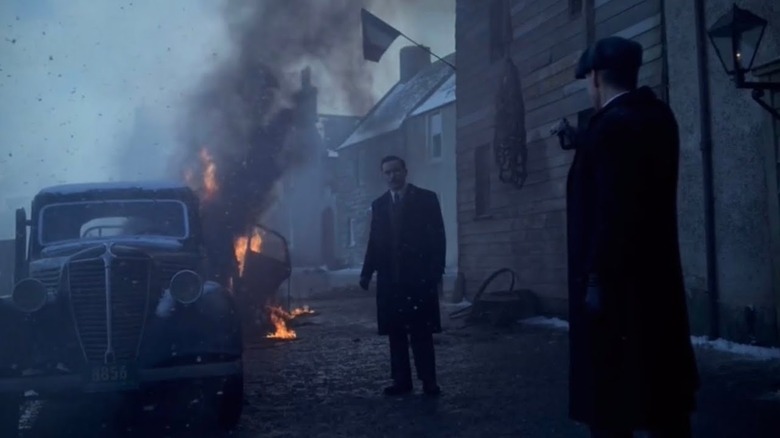The 7 Best And 7 Worst Things In Peaky Blinders
British television has always enjoyed great popularity around the world, from the wacky hijinks of "Monty Python" to the long-running "Doctor Who" series and from the comparatively staid "Downton Abbey" to the original "The Office."
One thing that British TV isn't known for is effective crime dramas. Although there are plenty of famous British police procedurals, including "Sherlock," "Midsomer Murders," and "Poirot" (as well as shows that play with the procedural format, like "Luther"), few British series focus on the other side of the law. While America was churning out hits like "The Sopranos," "The Wire," and "Breaking Bad" to global popularity, British crime shows remained a small market for a long time until the arrival of showrunner Steven Knight's new take on the genre, "Peaky Blinders," in 2013. A period drama loosely based on real events, "Peaky Blinders" takes an intimate look at the rise of the Shelby crime family in Birmingham, England, in the 1920s.
Bold, cinematic, stylish, and sexy in a way few shows have ever managed to be, "Peaky Blinders" relies on a cast of brilliant actors bringing their A-game to a story that is in turns mesmerizingly violent and heartbreakingly emotional. Over the course of 6 seasons, the series has seen a lot of highs and some inevitable lows. Let's take a look at some of the best things about "Peaky Blinders" as well as some of its worst aspects. Warning: Spoilers ahead.
Best: Stylish cinematography and soundtrack
If you ask a bunch of fans about the appeal of "Peaky Blinders," one word that will come up time and again is "cool." Despite taking place roughly a century ago amidst the filth and squalor of the most poverty-stricken parts of Birmingham, almost every shot of "Peaky Blinders" manages to look like an ad for some high-end luxury product.
A huge part of the credit for making the show look stylish rests with its cinematography team, for which Director of Photography George Steel won the BAFTA Craft award in 2014. With an emphasis on long, sweeping shots and natural lighting, the show often looks like a moving painting from a different era than a creation of modern times. This unique and arresting look also helps set the show apart from other period crime dramas like "Fargo" or "Boardwalk Empire."
The series also loves its slow-motion shots, accompanied by a surprising punk-rock soundtrack that's anachronistic in the best possible way. "You just know when a song is 'Peaky'," the show's lead actor Cillian Murphy explained to NME in 2019. "The artists are outsiders. They have resisted the tyranny of the mainstream."
Worst: A predictable story structure
The first season of "Peaky Blinders" dealt with Tommy Shelby (Cillian Murphy), an army veteran turned small-time gangster with ambitions of expanding his criminal empire beyond his home city. In order to do so, Tommy has to deal with his chaotic family members as well as bigger crime bosses like Billy Kimber (Charlie Creed-Miles) looking to shoot him down before he becomes a threat.
The second season of "Peaky Blinders" sees Tommy once again facing off against a bigger crime boss, Darby Sabini (Noah Taylor), while his personal problems threaten to derail his plans. Season 3 has Tommy needing to deal with a powerful shadowy organization headed by the sinister Father Hughes (Paddy Considine), even as his family's troubles threaten to spill over into his professional work. Noticing a pattern here?
Basically, each season of "Peaky Blinders" has Tommy and his family facing off against a bigger crime organization and managing to win in the end. The show itself made a reference to this pattern. In Episode 6 of Season 5, when Tommy is asked what he will do once he has defeated his latest arch-enemy, he simply replies, "I will continue until I find a man that I can't defeat." It takes some of the edge off watching Tommy confront a dangerous new enemy and winning in the end when you have seen him going through the same motions in every past season as well.
Best: Interesting main characters
When it started out, "Peaky Blinders" was not just a show about Tommy Shelby but also the entire Peaky crime family, each dealing with their personal demons in an unforgiving world. There's Arthur (Paul Anderson), Tommy's older brother who's prone to fits of rage followed by abject self-loathing; Polly Gray (Helen McCrory), Tommy's aunt who's lived a hard life and hardened her own heart as a result; Tommy's sister Ada (Sophie Rundle), who wants to leave a life of crime behind but keeps getting sucked back into it.
Later seasons see more compelling characters added to the plot, like Lizzie (Natasha O'Keeffe), the former prostitute who becomes Tommy's wife and suffers through his schemes and infidelities. Even the antagonistic characters like Major Campbell (Sam Neill) and Luca Changretta (Adrien Brody) get backstories that add to their motivations and make them much more than simple villains to be mowed down by the Blinders gang.
It would have been easy for the plot to get lost amongst the many interwoven character threads, but "Peaky Blinders" does a good job of making the characters' personal arcs part of the main narrative instead of letting them overpower the proceedings — at least in the first four seasons, before the focus started shifting exclusively toward Tommy.
Worst: Becoming all about Tommy
While Tommy Shelby was always the main character of "Peaky Blinders," he was a part of a large central cast, each of whom had a significant impact on the main plot so that the audience was kept hooked on their personal journeys. Sure, Tommy was the mastermind behind much of the success of the Peaky Blinders gang, but he could not have pulled any of it off without the help of Arthur, Polly, and the others.
With each successive season, viewers started to notice that "Peaky Blinders" was morphing into the "Tommy Shelby Show," and the other characters were taking on more of a supporting role. This change became fully realized when Joe Cole, who played Tommy's younger brother John, left the series in 2020. "With 'Peaky Blinders' I never really got out of the gates in that role," Cole told Metro. "It's Cillian's show really."
The problem was further aggravated by the real-life tragedy of the passing of actress Helen McCrory. As a result, Polly Gray's role in the series had to be scrapped entirely from Season 6, and once again Tommy is brought into the center of things to fight the main villains of the season alone while Arthur takes a backseat due to his struggles with opium addiction. Hopefully the upcoming "Peaky Blinders" movie will provide a more balanced view of Tommy and the rest of the Peaky gang.
Best: Cillian Murphy in the lead
While there have been valid complaints that later seasons of "Peaky Blinders" focus too much on Tommy Shelby, a major reason this happens is that Cillian Murphy is so damn good at playing the character. After establishing a reputation in Hollywood as a character actor in acclaimed supporting roles, "Peaky Blinders" finally allowed Murphy to take the center stage in a massively well-known project.
And boy, does he rise to the occasion. Murphy's Tommy Shelby is the lynchpin of the whole show. It's a testament to the actor's talent and raw charisma that Tommy has become a beloved hero to so many fans despite committing all kinds of brutal and unforgivable deeds. Whether raging against the system that keeps them down, expressing sympathy for an enemy, or allowing audiences a glimpse into his inner pain with a soulful look, Murphy makes Tommy into one of the most compelling protagonists in the history of film or television.
And to think show creator Steven Knight was initially hesitant to cast Murphy in the role. When the actor auditioned for the part, Knight thought he was too refined to ably play such a brutal character. But then Murphy texted Knight a simple message, "Remember, I'm an actor." Today Knight admits it is unthinkable that any other actor could have played Tommy as well as Murphy does.
Worst: Convenient plot changes
The world of "Peaky Blinders" is a large and messy one, and very often so is the fashion in which their story is told. Right from the first season, the show has frequently made jumps in logic for the sake of convenience, leading to hole-riddled plot lines that leave fans scratching their heads over the way characters behave in comparison to their past behavior.
One notable example is how Michael Gray (Finn Cole) goes from being a loyal and honorable member of Tommy's gang at the start to deciding to personally kill Tommy and take over his position in London in the final season. Or Arthur being repeatedly violent and antagonistic beyond all reason, only to be talked down from his rage and moved to tears in the final season by a guy he's never met before.
And then there's the matter of the next generation of Peaky Blinders, like Tommy's youngest brother Finn (Harry Kirton), who turned traitor in a matter of seconds in Season 6. Or Tommy's new secret son Duke (Conrad Khan), who is now apparently one of the gang's leading members despite only showing up for a couple of episodes. That kind of character development needs to be earned rather than being shoved down the throat of audiences within the span of a single episode.
Best: Strong female characters
One would think that the world of "Peaky Blinders" would have no place for strong female characters, what with all the gang wars and over-the-top machismo, and the fact that the show takes place in the repressive 1920s. But "Peaky Blinders" manages to subvert expectations with a series of pivotal female characters played by a talented roster of actresses.
First and foremost is Polly Gray, the matriarch of the Peaky Blinders crime family. For the longest time, Polly was the brains behind the gang and one of the very few people capable of making Tommy change his mind. Then there was Ada Shelby, who reluctantly goes back to being a member of the Peakys, and shows a natural talent for the work despite feeling deeply conflicted about the morality of her actions.
Finally, there's Grace (Annabelle Wallis), the woman who was sent undercover to spy on Tommy for the British government, but who ended up falling in love with him instead. Grace was the love of Tommy's life and his only hope for a happy ending — a hope that was dashed to pieces with Grace's demise. A number of other significant female characters pop up on the show over time, fighting just as hard as the men for their place in the sun and boldly taking on all the challenges the gangster lifestyle has to offer.
Worst: Major villains become unimportant
After a time, the villains on "Peaky Blinders" start resembling the "villain of the week" roster that plagues so many episodic crime shows. Fans started to notice that each fresh season brought with it yet another gangster that Tommy and his gang must deal with, only for the villain to be replaced with an even bigger threat next season.
While this started to get stale, what was worse was when the villains that had been set up for so long started receding into the background without any explanation. Oswald Mosley (Sam Claflin) was positioned in Season 5 as the greatest threat Tommy would ever face, yet the next season sees Mosley reduced to a sidekick for his wife Diana (Amber Anderson), who also does very little beyond making cryptic references to Hitler and Nazism.
The disappointment doesn't end there. The introduction of Gina Gray (Anya Taylor-Joy) and her uncle Jack Nelson (James Frecheville) promised to inject new vitality into the show as Tommy now has to deal with powerful American gangsters. But once again Season 6 reduced Gina and Jack to mere background characters who would occasionally say or do something sinister before coming up with a plan of attack that Tommy easily dismantles in the series finale.
Best: Connections to real history
The world of "Peaky Blinders" is incredibly deep and richly textured. One reason showrunner Steven Knight was able to create such a complex mythology was because he was working with real-life material. The Peaky Blinders were an actual gang that existed in London at the turn of the 20th century, which provided the basis for the show's central cast of characters.
Knight didn't stop there but continued to borrow real-life historical figures, like Billy Kimber and Winston Churchill, and incorporate real events, like the Great Depression and the looming threat of the Second World War. Of course, Knight takes many, many liberties with the source material to populate his version of the world of the Peaky Blinders and their enemies.
It's fun for fans to dive into the real history of the people and locations the series showcases, as well as the fashion and culture of that time period, which has seen a resurgence partly thanks to the popularity of "Peaky Blinders." In that sense, the show reads like a fun "What If?" scenario for real history, not unlike the revisionist historical dramas Quentin Tarantino is so well known for.
Worst: Magic escapes for Tommy
When "Peaky Blinders" was in its first season, Tommy Shelby was a determined but still very human man. He got outfought, outwitted, and outmaneuvered at various turns, and the thrill was in seeing Tommy's tenacity in coming back from a beating to settle the score with his enemies and still somehow manage to win the day.
But as the show progressed, Tommy started taking on a larger-than-life persona within the narrative. Not only did Tommy become the character that the entire series revolved around, but it started seeming that there was no problem too big and no challenge too great for Tommy to deal with single-handedly. Tommy is always two steps ahead of his enemies or just incredibly lucky.
As an example, in the Season 2 finale, Tommy is seconds away from being shot by enemy gangsters, only for one of them to turn out to be a secret government agent who saves Tommy's life at the last moment. The sixth season has Tommy at death's door with a seemingly incurable disease, only for it to be revealed at the eleventh hour that Tommy had never been sick in the first place. This kind of plot armor negatively affects the character, since audiences start assuming his life is never in any actual danger, no matter what situation the show places Tommy in.
Best: Alfie and Tommy as BFFs
Much has been written about the blinding charisma and authority that Cillian Murphy manages to imbue Tommy Shelby with. Nine times out of 10, Tommy dominates any room he steps into, but the 10th time, Tommy meets his match in Alfie Solomons (Tom Hardy).
Alfie is the Jewish gangster with whom Tommy works on multiple occasions. Despite Alfie double-crossing Tommy more than once, the two men have a strange sort of respect and even affection for each other that manifests in their private conversations, when Tommy appears fully relaxed and even manages to break out a smile or two.
For his part, Hardy absolutely kills every scene he's in as the idiosyncratic but hugely entertaining Alfie, and the arrival of Mr. Solomons is always widely anticipated by fans — so much so that Alfie returned for Season 6 despite being apparently killed off upon the insistence of Hardy himself. "It seemed ripe for Alfie not to be around but Tom loves the character," Showrunner Steven Knight told RadioTimes.com. "A lot. And so basically, we can't kill him."
Worst: Style over substance
Much has been written about the extremely stylish execution of "Peaky Blinders" as a whole, resembling the flashy world of Guy Ritchie movies and other glossy cinematic depictions of gangster lifestyle rather than the more grounded approach of shows like "The Sopranos." But this emphasis on style has often led to a corresponding reduction in the amount of substance "Peaky Blinders" offers audiences.
The slo-mo walks set to blaring rock music were used sparingly in the first few seasons, but started becoming much more common later on. Every piece of wardrobe on the show looks like it could be on a magazine cover. The triumph of style over substance can also be seen in how characters rarely change or evolve. Tommy Shelby is essentially still the same bitter, violent, and ambitious man he was at the start of Season 1, despite becoming an MP and having children and a wife in Season 6.
Arthur still has rage issues. Ada still resents her association with the Peaky Blinders. And Lizzie is still the long-suffering woman desperate for any morsel of love and affection. For all the fancy speeches Tommy and the other characters frequently indulge in, there is no deeper philosophy or meaning to the world of "Peaky Blinders" beyond violent men fighting over stray pockets of power and wealth, and hurting their loved ones in the process.
Best: Amazing action sequences
For the longest time, fancy action sequences were seen as the domain of big-budget action movies, not TV serials. That changed during the "Golden Age of Television" and the advent of streaming. Studios now have massive budgets with which to create shows of cinematic caliber to attract audiences.
"Peaky Blinders" takes advantage of this shift. The show does an amazing job of bringing the British gang wars of the 1920s to life in a thrilling manner. Whether audiences are watching Tommy blind a rival gang member with his peaky cap lined with razors or an all-out battle between the Peaky Blinders and Billy Kimber's army, the action scenes are always riveting.
What really helps sell such scenes is Cillian Murphy's surprisingly badass turn as an action hero. Sometimes cold and calculating, other times blazingly angry and brutal, Tommy Shelby is always watchable. His proficiency with violence is why he's risen through the ranks of the London underworld to become its most dreaded gangster. And let's not forget the human tornado of fearsome fury that is Tommy's brother Arthur.
Worst: An unsatisfying finale
By the end of its fifth season, "Peaky Blinders" had a lot of balls in the air. There was the creeping threat of fascism signaled by the arrival of Oswald Mosley. There was the advent of American gangsters as represented by Gina Gray. There were Tommy's escalating mental problems, which alienated his family and made it difficult for him to function.
Many fans wondered how the showrunners could possibly resolve all the plot threads that needed to be addressed before the sixth and final season of "Peaky Blinders" reached its conclusion. Turns out they couldn't. After setting up the showdown between Tommy and Michael all through the season, the latter gets taken out by a single shot from Tommy's gun. Not only does the series finale not resolve many existing plot threads, but it introduces several new ones into the mix that only convolute the main plot further.
Fans are hoping all these dangling threads will be sewn together in the upcoming "Peaky Blinders" movie, but even if that does end up being the case, there's still something deeply unsatisfying about watching the grand finale of "Peaky Blinders." There will never be another episode to answer so many questions regarding the fate of its main characters — or Tommy's pivotal battle against Mosley and his unique brand of fascism.
